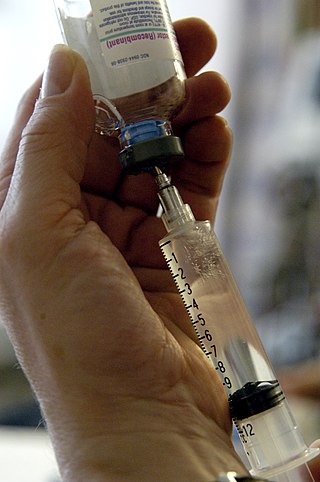Related Research Articles

In pharmacology and toxicology, a route of administration is the way by which a drug, fluid, poison, or other substance is taken into the body.

Subcutaneous administration is the insertion of medications beneath the skin either by injection or infusion.

Intramuscular injection, often abbreviated IM, is the injection of a substance into a muscle. In medicine, it is one of several methods for parenteral administration of medications. Intramuscular injection may be preferred because muscles have larger and more numerous blood vessels than subcutaneous tissue, leading to faster absorption than subcutaneous or intradermal injections. Medication administered via intramuscular injection is not subject to the first-pass metabolism effect which affects oral medications.

An injection is the act of administering a liquid, especially a drug, into a person's body using a needle and a syringe. An injection is considered a form of parenteral drug administration; it does not involve absorption in the digestive tract. This allows the medication to be absorbed more rapidly and avoid the first pass effect. There are many types of injection, which are generally named after the body tissue the injection is administered into. This includes common injections such as subcutaneous, intramuscular, and intravenous injections, as well as less common injections such as intraperitoneal, intraosseous, intracardiac, intraarticular, and intracavernous injections.

Leuprorelin, also known as leuprolide, is a manufactured version of a hormone used to treat prostate cancer, breast cancer, endometriosis, uterine fibroids, as part of transgender hormone therapy, for early puberty, or to perform chemical castration of violent sex offenders. It is given by injection into a muscle or under the skin.

Insulin glargine sold under the brand name Lantus among others is a long-acting modified form of medical insulin, used in the management of type I and type II diabetes. It is injected just under the skin. Effects generally begin an hour after use.

Buserelin, sold under the brand name Suprefact among others, is a medication which is used primarily in the treatment of prostate cancer and endometriosis. It is also used for other indications such as the treatment of premenopausal breast cancer, uterine fibroids, and early puberty, in assisted reproduction for female infertility, and as a part of transgender hormone therapy. In addition, buserelin is used in veterinary medicine. The medication is typically used as a nasal spray three times per day, but is also available for use as a solution or implant for injection into fat.

Nandrolone decanoate, sold under the brand name ROLON among others, is an androgen and anabolic steroid (AAS) medication which is used primarily in the treatment of anemias and wasting syndromes, as well as osteoporosis in menopausal women. It is given by injection into muscle or fat once every one to four weeks.

Trestolone, also known as 7α-methyl-19-nortestosterone (MENT), is an experimental androgen/anabolic steroid (AAS) and progestogen medication which has been under development for potential use as a form of hormonal birth control for men and in androgen replacement therapy for low testosterone levels in men but has never been marketed for medical use. It is given as an implant that is placed into fat. As trestolone acetate, an androgen ester and prodrug of trestolone, the medication can also be given by injection into muscle.

Histrelin acetate, sold under the brand names Vantas and Supprelin LA among others, is a nonapeptide analogue of gonadotropin-releasing hormone (GnRH) with added potency. When present in the bloodstream, it acts on particular cells of the pituitary gland called gonadotropes. Histrelin stimulates these cells to release luteinizing hormone and follicle-stimulating hormone. Thus it is considered a gonadotropin-releasing hormone agonist or GnRH agonist.

Insulin lispro, sold under the brand name Humalog among others, is a modified type of medical insulin used to treat type 1 and type 2 diabetes. It is delivered subcutaneously either by injection or from an insulin pump. Onset of effects typically occurs within 30 minutes and lasts about 5 hours. Often a longer-acting insulin like insulin NPH is also needed.

Oxogestone phenpropionate, also known as xinogestone, as well as 20β-hydroxy-19-norprogesterone 20β-(3-phenylpropionate), is a progestin related to the 19-norprogesterone derivatives which was developed as an injectable hormonal contraceptive, specifically a progestogen-only injectable contraceptive, in the 1960s and early 1970s but was never marketed. It was studied at a dose of 50 to 75 mg once a month by intramuscular injection but was associated with a high failure rate with this regimen and was not further developed. OPP is the 20β-(3-phenylpropionate) ester of oxogestone, which, similarly, was never marketed.

Nandrolone phenylpropionate (NPP), or nandrolone phenpropionate, sold under the brand name Durabolin among others, is an androgen and anabolic steroid (AAS) medication which has been used primarily in the treatment of breast cancer and osteoporosis in women. It is given by injection into muscle once every week. Although it was widely used in the past, the drug has mostly been discontinued and hence is now mostly no longer available.

Levonorgestrel butanoate (LNG-B), or levonorgestrel 17β-butanoate, is a steroidal progestin of the 19-nortestosterone group which was developed by the World Health Organization (WHO) in collaboration with the Contraceptive Development Branch (CDB) of the National Institute of Child Health and Human Development as a long-acting injectable contraceptive. It is the C17β butanoate ester of levonorgestrel, and acts as a prodrug of levonorgestrel in the body. The drug is at or beyond the phase III stage of clinical development, but has not been marketed at this time. It was first described in the literature, by the WHO, in 1983, and has been under investigation for potential clinical use since then.

Estrone (E1), sold under the brand names Estragyn, Kestrin, and Theelin among many others, is an estrogen medication and naturally occurring steroid hormone which has been used in menopausal hormone therapy and for other indications. It has been provided as an aqueous suspension or oil solution given by injection into muscle and as a vaginal cream applied inside of the vagina. It can also be taken by mouth as estradiol/estrone/estriol and in the form of prodrugs like estropipate and conjugated estrogens.

The pharmacology of estradiol, an estrogen medication and naturally occurring steroid hormone, concerns its pharmacodynamics, pharmacokinetics, and various routes of administration.

The pharmacokinetics of progesterone, concerns the pharmacodynamics, pharmacokinetics, and various routes of administration of progesterone.

Lynestrenol phenylpropionate (LPP), also known as ethynylestrenol phenylpropionate, is a progestin and a progestogen ester which was developed for potential use as a progestogen-only injectable contraceptive by Organon but was never marketed. It was assessed at doses of 25 to 75 mg in an oil solution once a month by intramuscular injection. LPP was associated with high contraceptive failure at the low dose and with poor cycle control. The medication was found to produce estrogenic effects in the endometrium in women due to transformation into estrogenic metabolites.

The pharmacology of testosterone, an androgen and anabolic steroid (AAS) medication and naturally occurring steroid hormone, concerns its pharmacodynamics, pharmacokinetics, and various routes of administration.

A depot injection is a term for an injection formulation of a medication which releases slowly over time to permit less frequent administration of a medication. They are designed to increase medication adherence and consistency, especially in patients who commonly forget to take their medicine. Depot injections can be created by modifying the drug molecule itself, as in the case of prodrugs, or by modifying the way it is administered, as in the case of oil/lipid suspensions. Depot injections can have a duration of action of one month or greater and are available for many types of drugs, including antipsychotics and hormones.
References
- ↑ Burgess, DJ; Wright, JC (2012). "An Introduction to Long Acting Injections and Implants". In Wright, JC; Burgess, DJ (eds.). Long Acting Injections and Implants. Springer New York. pp. 1–9. ISBN 9781461405542 . Retrieved 17 February 2024.
- ↑ Kumar, A; Pillai, J (2018). "Implantable drug delivery systems: An overview". In Grumezescu, AM (ed.). Nanostructures for the Engineering of Cells, Tissues and Organs. William Andrew. pp. 473–511. ISBN 978-0-12-813665-2 . Retrieved 17 February 2024.
- ↑ Kumar & Pillai 2018, p. 477.